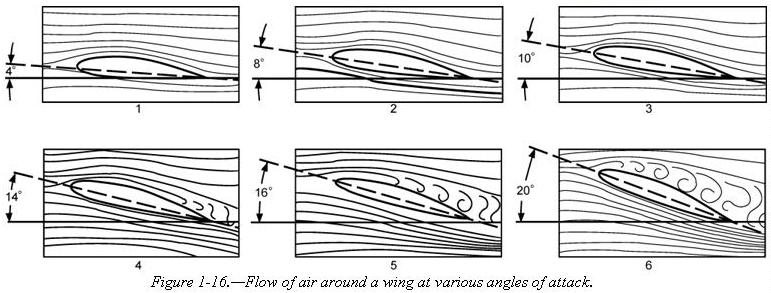
As stated previously, the angle of attack is the acute angle between
the relative wind and the chord line of the wing. At small angles of attack,
most of the wing lift is a result of the difference in pressure between
the upper and lower surfaces of the wing (Bernoulli’s Principle). Additional
lift is generated by the equal and opposite reaction of the airstream being
deflected downward from the wing (Newton’s Law).
 |
As the angle of attack is increased, the airstream is forced to travel faster because of the greater distance over the upper surface of the wing, creating a greater pressure differential between the upper and lower surfaces. At the same time, the airstream is deflected downward at a greater angle, causing an increased opposite reaction. Both the increased pressure differential and increased opposite reaction increase lift and also drag. Therefore as angle of attack is increased, lift is increased up to the critical angle of attack. [Figure 1-16]
When the angle of attack is increased to approximately 15° to 20° (critical angle of attack) on most airfoils, the airstream can no longer follow the upper curvature of the wing because of the excessive change in direction. As the critical angle of attack is approached, the airstream begins separating from the rear of the upper wing surface. As the angle of attack is further increased, the separation moves forward to the area of the highest camber. This causes a swirling or burbling of the air as it attempts to follow the upper surface of the wing.
When the critical angle of attack is reached, the turbulent airflow, which appeared near the trailing edge of the wing at lower angles of attack, quickly spreads forward over the entire upper wing surface. This results in a sudden increase in pressure on the upper wing surface and a considerable loss of lift. Due to the loss of lift and increase in form drag, the remaining lift is insufficient to support the airplane, and the wing stalls. [Figure 1-16]
To recover from a stall, the angle of attack must be decreased so that the airstream can once again flow smoothly over the wing surface. Remember that the angle of attack is the angle between the chord line and the relative wind, not the chord line and the horizon. Therefore, an airplane can be stalled in any attitude of flight with respect to the horizon, if the angle of attack is increased up to and beyond the critical angle of attack.